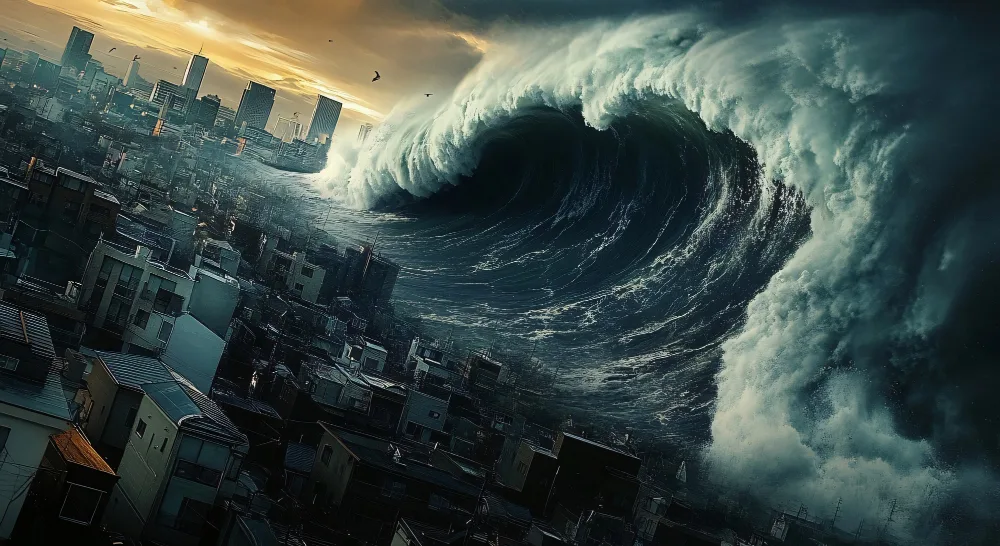KABARJAWA – The National Research and Innovation Agency (BRIN) triggered public attention after revealing the findings of Paleotsunami’s research which stated that the large tsunami in southern Java repeatedly in the 600-800 year cycle.
This finding confirms that the southern region of Java not only holds tourism potential and infrastructure development, but also the threat of devastating natural disasters that can shake at any time.
Associate Researcher Center for Geological Disaster Research (PRKG) Brin, Purna Sulastya Putra, explained that Paleotsunami is a scientific study that traces the traces of ancient tsunamis that are not recorded in human history.
This study was conducted to understand the recurrent pattern of the tsunami disaster, as well as giving an overview for today’s generation of the dangers that lurk behind the beauty of the southern sea of Java.
According to him this research is very important because southern Java continues to develop with the development of strategic infrastructure. Whereas on the other hand, the threat of a giant tsunami that repeatedly has not been fully understood and anticipated.
“All parties must encourage the same understanding and later how to anticipate it,” said Purna in an official statement, Sunday (8/17/2025).
The findings of ancient tsunami traces in southern Java
The Brin research team found an ancient tsunami sedimentary layer of around 1,800 years at various points along southern Java, ranging from Lebak, Pangandaran, to Kulonprogo.
According to Purna, the broad distribution of the trail shows that the large tsunami once hit this area due to the megathrust earthquake with the power of reaching magnitude of 9.0 or more.
“This is not the only one. Other giant tsunami footprints were found to be around 3,000 years old, 1,000 years, and 400 years ago,” he said.
Paleotsunami research was conducted through field observation in the swamp and laguna areas. The environment was chosen because sea sediment carried by tsunami waves is more easily recognized and preserved.
To ensure that the layer is really a tsunami deposit, the team conducted further analysis such as microfauna tests, chemical elements, to radiocarbons.
However, Purna acknowledged the big challenges in this study. Not all ancient tsunami deposits are able to survive intact, and some of them are difficult to distinguish from sediments due to floods or storms.
Threats of tsunamis and population explosions on the coast
Brin warned that this threat must be considered serious because the population on the southern coast of Java continues to increase. The projection shows that more than 30 million people will be exposed to tsunami risk in 2030.
This fact increases the urgency of disaster mitigation, especially in the midst of large -scale infrastructure development that is intensively carried out by the government and the private sector.
Airports, ports and industrial areas are now growing rapidly in southern Java. However, Brin assessed that most of the development had not fully integrated tsunami risk analysis.
“If infrastructure is not designed by considering the history of the disaster, the impact will be very large, both in terms of fatalities and economic losses,” said Purna.
Tourism development can enlarge vulnerability
In addition to strategic infrastructure projects, the South Coastal area of Java is also crowded with the construction of new hotels, restaurants and tourist destinations. Tourism activities do bring economic benefits, but at the same time adding to the vulnerability of the region to the tsunami threat.
“Increasing this activity, although it has a positive impact from the economic side, also indirectly adds to the vulnerability of the region on the potential for tsunami disasters,” added Purna.
HOPE BRIN: Data Becomes the Foundation of Spatial Policy
Purna emphasized that Paleotsunami data collected by Brin could be an important foundation in the determination of spatial policy and disaster mitigation.
Information about the distribution of affected areas, the tsunami repeat period, to the estimated inundation distance can be used to determine the vulnerable zone, the location of the evacuation, and the efficient rescue pathway.
In addition, Brin also encourages research -based disaster education to be increased. Disaster preparedness material must touch schools, mass media, to local communities.
“If there is a strong earthquake near the coast, do not wait for sirens or notifications. Immediately evacuate to a higher place. Nature often gives the first signal, and preparedness is the key to safety,” concluded Purna.
Between development and preparedness
The southern region of Java is now at a crossroads. On the one hand, stretching development opens great economic opportunities. On the other hand, the threat of giant tsunamis that repeatedly every hundreds of years become a shadow that should not be ignored.
Brin asserted that only with research -based planning, development can run in line with disaster preparedness.
The community, the government, and business actors need to work together so that the stretching of development does not turn into a new source of vulnerability in the future.
Game Center
Game News
Review Film
Rumus Matematika
Anime Batch
Berita Terkini
Berita Terkini
Berita Terkini
Berita Terkini
review anime


